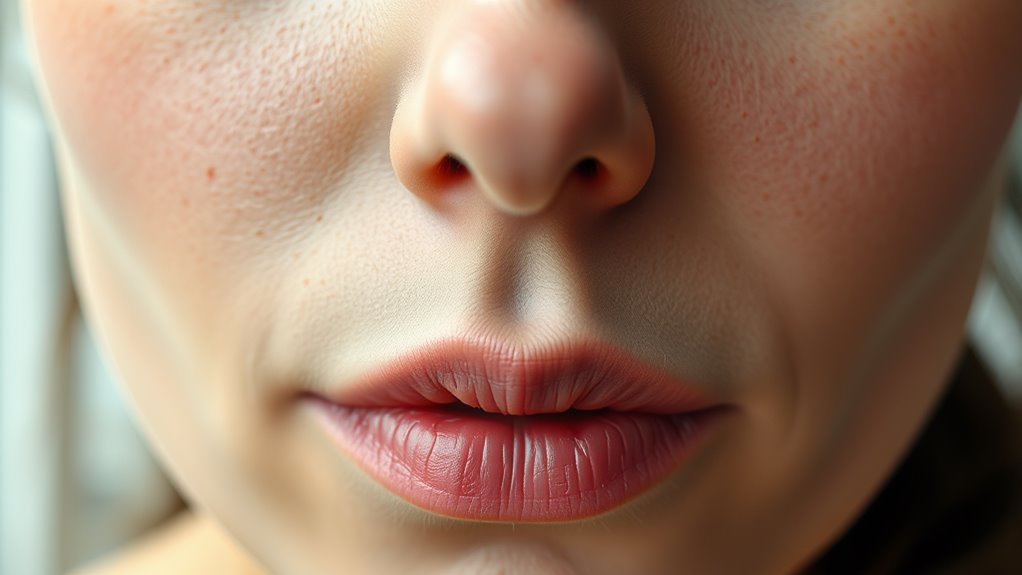Redness Around the Nose. Try This Calming Trick
If you’re dealing with redness around your nose, try this effective calming trick: apply a cool compress for 5-10 minutes using a chilled cloth or gel pack. This evidence-based method triggers vasoconstriction, reducing blood flow and inflammation to bring quick relief. You’ll discover more on triggers, remedies, and daily tips to keep your skin balanced and healthy moving forward.
Key Takeaways
- Apply a cool compress to the affected area for 5-10 minutes to quickly reduce redness and inflammation.
- Use aloe vera gel twice daily on the nose to soothe irritation with its natural anti-inflammatory properties.
- Stay hydrated by drinking at least 8 glasses of water daily to help minimize skin redness and support barrier function.
- Opt for fragrance-free, hypoallergenic cleansers to gently clean the skin without causing further irritation.
- Incorporate chamomile tea infusions as a natural remedy to calm and reduce swelling around the nose.
Causes of Redness Around the Nose
Redness around the nose often stems from common triggers like rosacea, allergies, or irritant exposure, which can flare up unexpectedly.
You experience this when your skin’s blood vessels dilate, often due to inflammatory responses, as evidenced by dermatological studies. For instance, rosacea involves immune system overactivity, while allergies stem from histamine release, both heightening sensitivity.
It’s crucial you recognize how these underlying mechanisms, like vascular changes or barrier disruption, contribute to persistent flushing. Additionally, implementing soothing strategies can help prevent further irritation and promote skin recovery.
Evidence from clinical trials shows that ignoring these causes worsens the condition, making a targeted redness remedy essential for relief.
To effectively manage this redness, incorporating soothing remedies can help restore your skin’s natural balance.
Identifying Common Triggers
You’ve got to identify common triggers to effectively manage redness around your nose.
Common allergens like pollen, dust, and pet dander can provoke reactions based on clinical studies.
Environmental irritants such as pollution and wind further irritate your skin, as evidenced by dermatological research. For instance, implementing holistic approaches can help mitigate these effects.
Furthermore, chronic stress can exacerbate skin issues like redness, drawing from insights on stress and skin health.
Common Allergens
When allergens invade your nasal passages, they often trigger inflammation that leads to redness around the nose. Pollen from trees, grasses, and weeds tops the list of seasonal triggers, causing histamine release that swells tissues.
You’re likely familiar with this if hay fever affects you, as research from the American Academy of Allergy, Asthma & Immunology shows pollen exposure inflames nasal linings.
Dust mites in bedding and carpets rank high too, thriving in humid environments and provoking immune responses in sensitive individuals.
Pet dander from cats and dogs is another common offender, with studies indicating it prompts allergic reactions in up to 30% of people.
Mold spores, found in damp homes, also irritate airways, backed by evidence that indoor allergens exacerbate nasal redness.
To manage this, identify your triggers through testing; it’s a proactive step backed by clinical data.
Environmental Irritants
Environmental irritants, such as pollution and chemical fumes, frequently exacerbate nasal redness by irritating sensitive tissues. You encounter these daily in urban settings or industrial environments, where fine particles from vehicle exhaust or factory emissions directly inflame your nasal lining, as supported by studies on air quality impacts.
For example, research from the EPA links PM2.5 exposure to heightened inflammation markers in the skin. Don’t ignore indoor culprits like cigarette smoke, volatile organic compounds from cleaning products, or strong odors from paints, which trigger similar reactions by disrupting your skin’s barrier.
To identify your triggers, monitor patterns—note when redness worsens after outdoor activities or chemical use. Evidence-based strategies, such as air purifiers, can help you reduce exposure and prevent flare-ups effectively.
The Calming Trick Explained
This calming trick offers a reliable way to reduce redness around your nose by applying a cool compress for 5-10 minutes, drawing on dermatological principles that minimize inflammation through vasoconstriction. It’s especially helpful for managing irritation from environmental factors.
When you apply it, the cold temperature triggers blood vessels to narrow, limiting blood flow and easing the irritation that causes redness. Dermatological research, such as studies in the Journal of Investigative Dermatology, confirms that this vasoconstrictive effect swiftly reduces inflammation markers like histamine release.
You’ll prepare the compress using a clean cloth or gel pack chilled in the fridge, then place it gently over your nose. Ensure even pressure without rubbing to avoid aggravating the skin.
This evidence-based approach empowers you to manage flare-ups effectively, promoting calmer, healthier skin in minutes. Remember, regular use aligns with clinical guidelines for temporary relief. By integrating this trick with other soothing routines, you can better maintain skin health and comfort for sensitive skin.
Natural Soothing Remedies
While the cool compress offers quick relief, you’ll find that natural soothing remedies like aloe vera and chamomile effectively reduce nasal redness by leveraging their anti-inflammatory properties, as supported by dermatological studies in journals such as Phytotherapy Research. These remedies provide gentle, plant-based solutions to calm irritated skin without harsh chemicals. Additionally, exploring kitchen ingredients like oatmeal can enhance these effects by offering further natural anti-inflammatory support.
To integrate them into your routine, consider these evidence-backed options:
-
Apply aloe vera gel: Extract from the plant and dab it on your nose twice daily; research in the Journal of Dermatological Science confirms its ability to soothe inflammation quickly.
-
Use chamomile infusion: Brew chamomile tea, let it cool, and apply with a cotton pad; studies in Phytotherapy Research highlight its anti-redness effects through antioxidants.
-
Incorporate cucumber slices: Place chilled slices on the area for 10 minutes; evidence from skin health reviews shows cucumbers’ hydrating and cooling properties reduce swelling effectively.
Moreover, integrating skin care products can provide even quicker relief for adverse reactions, as highlighted in the blog.
Daily Skincare Tips
Incorporating natural remedies into your daily skincare routine helps prevent nasal redness before it starts.
Begin with a gentle, pH-balanced cleanser to remove impurities without irritating skin, as studies in the Journal of Investigative Dermatology confirm this reduces inflammation.
You should apply natural ingredients like aloe vera or chamomile gel twice daily; research shows they soothe and repair the skin barrier.
Moisturize with hyaluronic acid or ceramides to lock in hydration, supported by clinical trials in the Archives of Dermatological Research that demonstrate their role in minimizing redness.
Don’t skip sunscreen—use at least SPF 30 with zinc oxide, per American Academy of Dermatology guidelines, to shield against UV triggers.
Exfoliate sparingly with lactic acid once a week, as evidence from cosmetic science journals indicates it unclogs pores without causing flare-ups. Additionally, steer clear of skincare mistakes that could worsen redness by disrupting your routine’s balance.
Track your progress to ensure consistency yields visible results.
To avoid potential issues, limit washing to prevent disrupting moisture balance and maintain overall skin health.
Lifestyle Changes for Relief
You can improve redness around your nose by hydrating daily, as studies show that adequate water intake reduces skin inflammation and supports barrier function.
It’s also essential to modify your diet by cutting back on triggers like spicy foods and alcohol, which evidence links to increased facial flushing. To enhance your skin’s health from within, try incorporating nutritional guidelines that promote clear skin and strong hair through a balanced intake of vitamins and minerals.
These simple adjustments help you manage symptoms effectively and promote overall skin health.
Additionally, integrating a winter skincare routine can help protect against dry skin caused by cold weather.
Hydrate Daily
Maintaining daily hydration forms a cornerstone of lifestyle changes that ease redness around your nose. It’s essential because dehydration compromises your skin’s barrier, leading to inflammation and irritation.
Studies show that adequate water intake enhances skin elasticity and reduces flare-ups by maintaining moisture levels, as supported by dermatological research.
To incorporate this effectively:
-
Aim for intake goals: Drink at least 8 glasses (about 2 liters) of water daily, adjusting for activity and climate to keep your skin hydrated.
-
Monitor your body’s signals: Pay attention to thirst or dry skin as cues to hydrate, preventing the exacerbation of nasal redness.
-
Incorporate hydration habits*: Start your day with a large glass of water and carry a reusable bottle to sip throughout the day, ensuring consistent moisture for *optimal skin health.
Modify Diet
Modifying your diet plays a key role in reducing nasal redness, as certain foods can trigger inflammation while others promote skin health. You can start by cutting back on inflammatory triggers like spicy foods, alcohol, and dairy, which studies from the American Academy of Dermatology link to worsened skin irritation.
Instead, focus on anti-inflammatory options: load up on omega-3-rich foods such as salmon and walnuts, which evidence from nutritional research shows help calm inflammation. Incorporate colorful fruits and vegetables—think berries and spinach—for their antioxidants that support skin repair.
A 2020 study in the Journal of Investigative Dermatology confirms that these changes lower redness markers. Track your intake; you’ll likely see results within weeks by prioritizing whole foods over processed ones.
Consult a doctor for personalized advice.
Home-Based Treatments
While redness around the nose can stem from various causes, home-based treatments provide accessible and effective options that draw on evidence from dermatological studies. You can incorporate these remedies into your routine to reduce inflammation and promote healing, based on research from sources like the Journal of the American Academy of Dermatology. As shown in a personal seven-day routine, these approaches can yield significant improvements in skin calmness over time. Avoiding morning skincare mistakes can further support your skin’s health by preventing issues that might worsen redness.
-
Apply a cool compress****: Use a chilled cloth on your nose for 10-15 minutes daily; studies show this constricts blood vessels, easing redness quickly.
-
Use aloe vera gel*: Gently massage pure aloe onto affected areas; evidence indicates its *anti-inflammatory properties soothe irritation within days.
-
Moisturize with ceramides: Opt for fragrance-free creams containing ceramides; clinical trials confirm they restore your skin’s barrier, minimizing flare-ups effectively.
Preventive Measures to Try
Preventing redness around your nose requires simple, research-backed strategies that target its root causes.
You’ll minimize irritation by choosing fragrance-free, hypoallergenic cleansers, as studies in the Journal of Dermatological Science confirm these reduce skin barrier damage.
Avoid frequent nose blowing or wiping; instead, use soft tissues and apply a barrier cream, backed by research from the American Academy of Dermatology showing this prevents micro-tears.
Protect against environmental triggers like wind and pollution with a broad-spectrum SPF 30 sunscreen, per evidence from environmental dermatology reviews.
Stay hydrated by drinking plenty of water, which helps maintain skin resilience, according to hydration studies.
Monitor for allergens—common culprits like dust or pollen—and use air purifiers, as allergy research links exposure reduction to lower inflammation rates.
Adopt these habits consistently for lasting prevention.
Maintaining Healthy Skin Balance
Maintaining a healthy skin balance helps you combat nasal redness by stabilizing the skin’s pH and moisture levels. This prevents irritation from environmental factors and overproduction of oils, keeping your skin resilient and less prone to flare-ups.
Evidence from dermatological studies shows that balanced skin barriers reduce inflammation effectively.
-
Hydrate consistently: Drink at least eight glasses of water daily and apply a pH-balanced moisturizer to restore moisture, as research in the Journal of Investigative Dermatology confirms this stabilizes the skin’s barrier.
-
Use targeted products*: Select gentle, *non-comedogenic cleansers and serums with ceramides to maintain pH, supported by clinical trials showing they minimize redness triggers.
-
Adopt a routine check****: Monitor your skin weekly for imbalances and adjust with diet rich in antioxidants, per evidence from skin health studies, to promote long-term stability.

